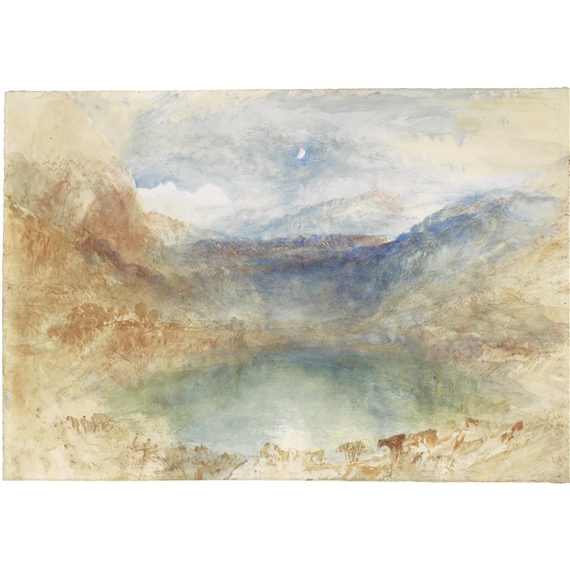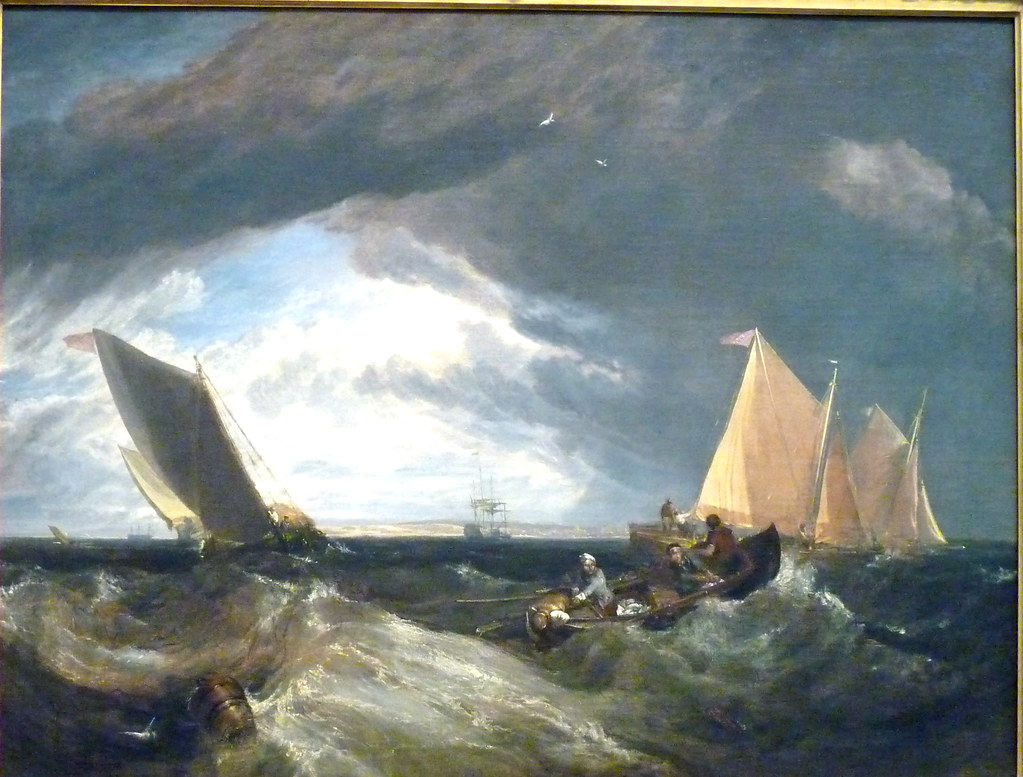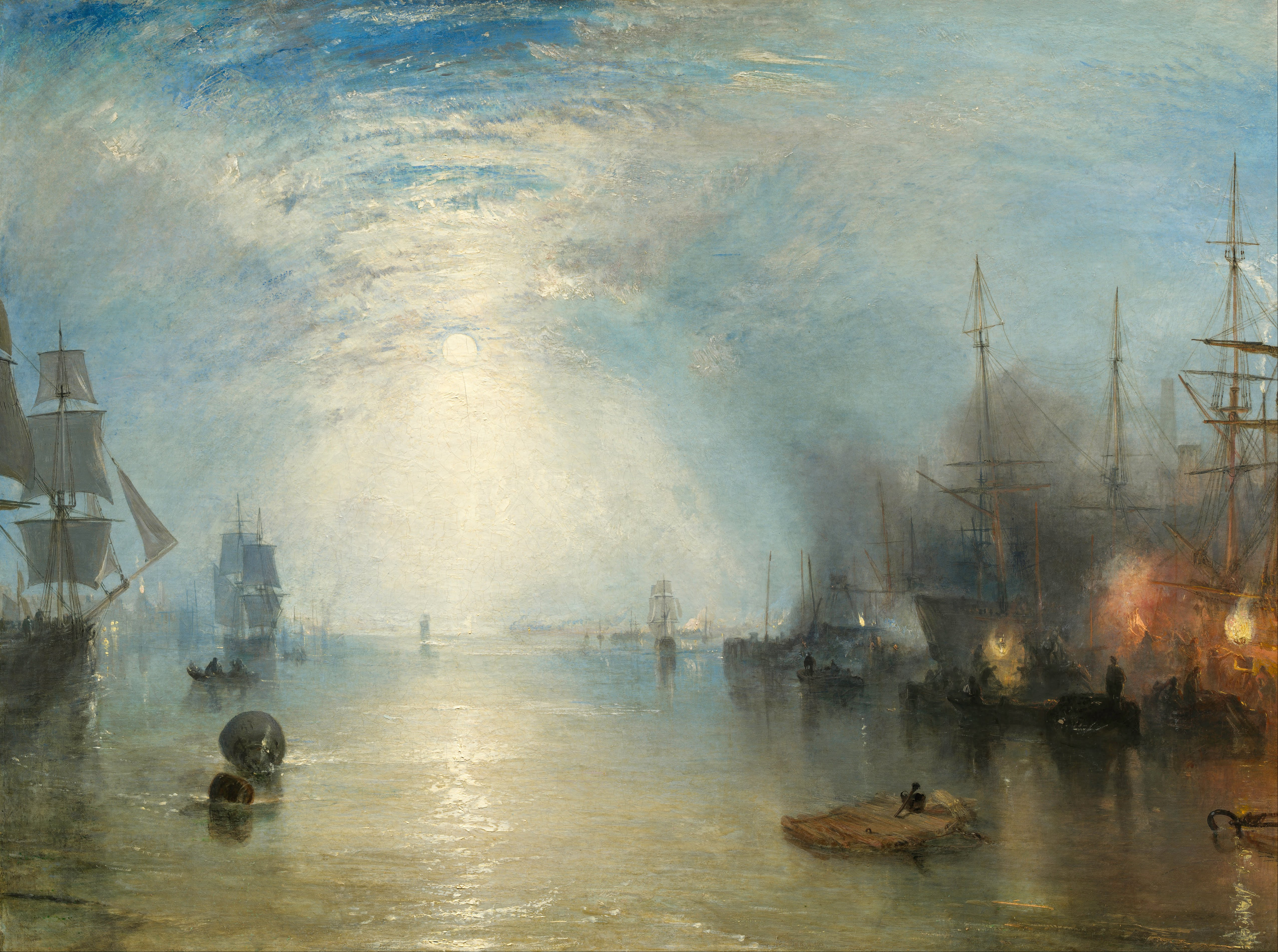Biography
JOSEPH MALLORD WILLIAM TURNER was born on Maiden Lane in Covent Garden, London, in 1775 (the actual day is uncertain, but Turner maintained it was Saint George's Day, 23 April), the only son of William Turner and Mary Marshall. His mother, who was mentally unstable, was committed to Bethlem asylum for the insane in 1800, and died in 1804. During his only sister's fatal illness (she died in 1786) Turner was sent to live with his mother's brother in Brentford and attended Brentford Free School; this was his only formal education. His early artistic talent was encouraged by his father, who exhibited his drawings in his shop window (the father remained a devoted supporter and, later, was his son's studio assistant and general factotum until his death in 1829).In 1789, the year of his first extant sketchbook from nature, Turner entered the Royal Academy Schools, also working at about this time in the studio of the architectural draftsman and topographer Thomas Malton. He exhibited his first watercolor at the Royal Academy in 1790 and his first oil in 1796; thereafter he exhibited nearly every year until a year before his death. He stayed with his father's friend, John Narraway, in Bristol in 1791, and from then on until the end of the Napoleonic Wars made frequent summer sketching tours in various parts of Britain. In 1794 he published his first two engravings, and in 1798 began drawings for The Oxford Almanack. Probably beginning in 1794 he worked for three years at Dr. Monro's evening "academy" in the company of Thomas Girtin, Edward Dayes, and others.
Turner's precocity led to his election as an Associate of the Royal Academy in 1799, and to full Academicianship in 1802. He revered the Academy all his life, was assiduous as a member of the council and hanging committee and as auditor of the accounts, and was proud to be appointed its professor of perspective in 1807, from 1811 until 1828 giving lectures that ranged widely over the problems of landscape painting. He moved from Maiden Lane to lodgings on Harley Street in 1799, opening his own gallery in contiguous premises on Queen Anne Street in 1804; this he enlarged between 1819 and 1822. In 1805 he took a house at Isleworth, keeping a second home on the riverside at intervals for the rest of his life (Upper Mall, Hammersmith, from 1806 to 1811; Sandycombe Lodge, Twickenham, from 1813 to about 1825; Cheyne Walk, from about 1846 onward).
Turner made his first journey abroad in 1802, traveling through France to Switzerland, and studying in the Louvre on his return. In 1817 he visited the Low Countries and subsequently traveled more frequently on the Continent (until 1845), less frequently in the British Isles (until 1831). Between 1819 and 1820 he paid his first visit to Italy, staying principally in Venice and Rome; he revisited Venice in 1833, 1835 (probably), and 1840.
He worked continuously for the publishers of illustrated books; his illustrations appeared at intervals between 1827 and 1835. Turner made his reputation as a topographical watercolorist, sketching from nature, mainly in pencil, the sketches serving as a repository of ideas of which he might make use months or even years afterward. He was determined to raise landscape painting to the level of ideal art, closer in the hierarchy of genres to history painting, and he experimented first in watercolor then in oils with many new techniques.
For some twenty years, from about 1798, he maintained a liaison with Sarah Danby, with whom he had two daughters, but he never married. In old age, following the death of his father and close friends, he became increasingly pessimistic and morose, allowed the house and picture gallery on Queen Anne Street to become dilapidated, and finally lived largely in his cottage on Cheyne Walk, cared for by his housekeeper, Mrs. Booth. There he died on 19 December 1851. He was buried in Saint Paul's Cathedral, London.
A magnificent work by Joseph Mallord William Turner, The Temple of Jupiter Panellenius– is one of the most important oil paintings by the artist remaining in private hands (est. $12/16 million). The work has been in the private collection of prominent fineart dealer Richard L. Feigen for over twenty-five years, and was a highlight of the retrospective of the work of JMW Turner RA presented in 2008 by The Metropolitan Museum of Art in New York, The National Gallery of Art in Washington, D.C., and the Dallas Museum of Art. The Temple of Jupiter Panellenius is one of only three oil landscapes concerned with ancient Greece painted by Turner, and is one of less than twenty significant paintings by the artist still held in private hands.
“The Graphic Society, 1837 J.M.W. Turner, Bamborough Castle, watercolour, estimate: £1.5–2.5 million*
Sotheby’s offeried the artist’s lost masterpiece, Bamborough Castle, on Wednesday, December 5, 2007. Described by the Graphic Society in 1837 as “one of the finest watercolour-drawings in the world ”this major work looks set to generate huge excitement in the academic and collecting worlds alike. Itis expected to fetch in excess of £1.5 million. Dating from the mid 1830s, Turner’s Bamborough Castlehas spent most of its life to date in the possession of a distinguished private collection and, remarkably, it has not been seen on the open market since 1872 - some 135 years. In 1872 it wassold as part of the Joseph Gillott collection in London and realised £3,309, the highest price ever achieved for a watercolour at the time. The Earl of Dudley was the purchaser on this occasion but later - in about 1890 - the picture passed into the hands of one of the great American collecting families, that of the Vanderbilts.
The Vanderbilt family played a significant role in the history of the United States; they built a shipping and railroad empire during the 19thcentury which made them one of the wealthiest families in the world. Since entering the collection of Mrs Cornelius Vanderbilt, the watercolour has passed down through successive generations of the family while the outside world has remained mystified as to its whereabouts. Listed as untraced in Andrew Wilton’s Catalogue of Turner Watercolours published in 1979, the work has not been seen in public since 1889. Perched on an outcrop on the very edge of the North Sea at Bamborough, Northumberland, Bamborough Castle is one of England’s finest castles.
In his watercolour, Turner has chosen to show the castle from its north side, the angle which clearly portrays the height and presence of the castle’s impressive Norman walls. The formidable castle is serenely depicted as the one point of safety in themidst of a charged landscape. In the foreground, awoman and girl appear to cower from the large roiling waves while a ship struggles to reach the security of the land under the great storm clouds. In the 19thcentury the castle had a reputation for being one of the great places of refuge on the British coast during storms for sailors in distress. It actually had rooms within the walls that wereput aside for rescued sailors as well as a marine rescue party that constantly patrolled an eight-mile stretch of the coast north and south of the castle.Turner was a great admirer of such details and hecaptures the castle’s preparations with a rocket launched in the distance and people gathered at the waters-edge, ready to rescue the sailors who are rowing away from their vessel that has struck the massive rocks.
The watercolour, which measures 505x705mm, relates to an earlier pencil drawing of the castle from 1797. The work has all of Turner’s signature elements; his energetic handling of colour which is often applied in rapid scratch-like strokes, or smeared into place with his fingertips, or scratched away with the tip of a brush to reveal the paper beneath.
Henry Wemyss, Head of British Watercolours at Sotheby’s, comments: “This watercolour fully demonstrates the genius of Turner and it’s a real treat to have the privilege of bringing it to sale. Its recent re-discovery after more than a century away from the public eye, alongside its dramatic and powerful British subject, result in an incredibly rare and special work of art. The market in 1872 made it not only the most valuable watercolour, but more expensive than many Turner oils. I think the Graphic Society got it right in 1837 when they described it as ‘one of the finest watercolour-drawingsin the world.’” Research on the painting is still in progress, but it is possible that the work may shed new light on Turner’s working practices. It seems, for instance, that here Turner has backed the sheet of paper with two further laminated sheets – no doubt to strengthen the paper but also, possibly to intensify the colours he used.
The Vanderbilt family played a significant role in the history of the United States; they built a shipping and railroad empire during the 19thcentury which made them one of the wealthiest families in the world. Since entering the collection of Mrs Cornelius Vanderbilt, the watercolour has passed down through successive generations of the family while the outside world has remained mystified as to its whereabouts. Listed as untraced in Andrew Wilton’s Catalogue of Turner Watercolours published in 1979, the work has not been seen in public since 1889. Perched on an outcrop on the very edge of the North Sea at Bamborough, Northumberland, Bamborough Castle is one of England’s finest castles.
In his watercolour, Turner has chosen to show the castle from its north side, the angle which clearly portrays the height and presence of the castle’s impressive Norman walls. The formidable castle is serenely depicted as the one point of safety in themidst of a charged landscape. In the foreground, awoman and girl appear to cower from the large roiling waves while a ship struggles to reach the security of the land under the great storm clouds. In the 19thcentury the castle had a reputation for being one of the great places of refuge on the British coast during storms for sailors in distress. It actually had rooms within the walls that wereput aside for rescued sailors as well as a marine rescue party that constantly patrolled an eight-mile stretch of the coast north and south of the castle.Turner was a great admirer of such details and hecaptures the castle’s preparations with a rocket launched in the distance and people gathered at the waters-edge, ready to rescue the sailors who are rowing away from their vessel that has struck the massive rocks.
The watercolour, which measures 505x705mm, relates to an earlier pencil drawing of the castle from 1797. The work has all of Turner’s signature elements; his energetic handling of colour which is often applied in rapid scratch-like strokes, or smeared into place with his fingertips, or scratched away with the tip of a brush to reveal the paper beneath.
Henry Wemyss, Head of British Watercolours at Sotheby’s, comments: “This watercolour fully demonstrates the genius of Turner and it’s a real treat to have the privilege of bringing it to sale. Its recent re-discovery after more than a century away from the public eye, alongside its dramatic and powerful British subject, result in an incredibly rare and special work of art. The market in 1872 made it not only the most valuable watercolour, but more expensive than many Turner oils. I think the Graphic Society got it right in 1837 when they described it as ‘one of the finest watercolour-drawingsin the world.’” Research on the painting is still in progress, but it is possible that the work may shed new light on Turner’s working practices. It seems, for instance, that here Turner has backed the sheet of paper with two further laminated sheets – no doubt to strengthen the paper but also, possibly to intensify the colours he used.
JOSEPH MALLORD WILLIAM TURNER, R.A. (1775-1851) is Britain’s greatest watercolourist and the last few years have seen him take centre stage like never before. In July of this year Sotheby’s offered for sale the Ullens Collection, the finest collection of privately-owned Turner watercolours to have come to the market in living memory, which saw the artist’s
Lungernzee realise £3.6 million.
Hot on the heels of this, a major exhibition entitled J.M.W.Turner has just opened at the National Gallery of Art in Washington D.C. This actually follows record new prices in 2006 when one of Turner’s Venice masterpieces sold for $35.8 million in New York while his
The Blue Rigi fetched £5.8 million in London.
Sotheby's 2008
Lungernzee realise £3.6 million.
Hot on the heels of this, a major exhibition entitled J.M.W.Turner has just opened at the National Gallery of Art in Washington D.C. This actually follows record new prices in 2006 when one of Turner’s Venice masterpieces sold for $35.8 million in New York while his
The Blue Rigi fetched £5.8 million in London.
Sotheby's 2008
Joseph Mallord William Turner R.A.
LOT SOLD. 51,650 GBP Sotheby's 2013
Joseph Mallord William Turner R.A.
LOT SOLD. 4,562,500 USDJoseph Mallord William Turner, R.A.
LOT SOLD. 266,500 GBPJoseph Mallord William Turner, R.A.
LOT SOLD. 98,500 GBPJoseph Mallord William Turner
LOT SOLD. 509,000 USD Sotheby's 2014
Joseph Mallord William Turner, R.A.
LOT SOLD. 30,322,500 GBPJoseph Mallord William Turner, R.A.
LOT SOLD. 176,500 GBP Joseph Mallord William Turner, R.A.
LOT SOLD. 182,500 GBP
Joseph Mallord William Turner, R.A.
LOT SOLD. 266,500 GBP
Joseph Mallord William Turner, R.A.
LOT SOLD. 302,500 GBJoseph Mallord William Turner, R.A.
LOT SOLD. 104,500 GBPNational Gallery (Washington, DC)
- Turner, Joseph Mallord William
- , British, 1775 - 1851
- The Junction of the Thames and the Medway
- 1807
- oil on canvas
- overall: 108.8 x 143.7 cm (42 13/16 x 56 9/16 in.)
- framed: 148 x 180.3 cm (58 1/4 x 71 in.)
- Widener Collection
- 1942.9.87
- Turner, Joseph Mallord William
- , British, 1775 - 1851
- Mortlake Terrace
- 1827
- oil on canvas
- overall: 92.1 x 122.2 cm (36 1/4 x 48 1/8 in.)
- framed: 111.1 x 143.2 x 9.5 cm (43 3/4 x 56 3/8 x 3 3/4 in.)
- Andrew W. Mellon Collection
- 1937.1.109
- Turner, Joseph Mallord William
- , British, 1775 - 1851
- Rotterdam Ferry-Boat
- 1833
- oil on canvas
- overall: 92.3 x 122.5 cm (36 5/16 x 48 1/4 in.)
- framed: 115.6 x 146 x 7.6 cm (45 1/2 x 57 1/2 x 3 in.)
- Ailsa Mellon Bruce Collection
- 1970.17.135
- Turner, Joseph Mallord William
- , British, 1775 - 1851
- Venice: The Dogana and San Giorgio Maggiore
- 1834
- oil on canvas
- overall: 91.5 x 122 cm (36 x 48 1/16 in.)
- framed: 125.7 x 156.5 x 14 cm (49 1/2 x 61 5/8 x 5 1/2 in.)
- Widener Collection
- 1942.9.85
- Turner, Joseph Mallord William (painter)
- , British, 1775 - 1851
- Keelmen Heaving in Coals by Moonlight
- 1835
- oil on canvas
- overall: 92.3 x 122.8 cm (36 5/16 x 48 3/8 in.)
- framed: 127.6 x 158.1 x 14 cm (50 1/4 x 62 1/4 x 5 1/2 in.)
- Widener Collection
- 1942.9.86
- Turner, Joseph Mallord William
- , British, 1775 - 1851
- The Rape of Proserpine
- 1839
- oil on canvas
- overall: 92.6 x 123.7 cm (36 7/16 x 48 11/16 in.)
- framed: 124.1 x 154.9 x 10.1 cm (48 7/8 x 61 x 4 in.)
- Gift of Mrs. Watson B. Dickerman
- 1951.18.1
- Turner, Joseph Mallord William
- , British, 1775 - 1851
- The Dogana and Santa Maria della Salute, Venice
- 1843
- oil on canvas
- overall: 62 x 93 cm (24 7/16 x 36 5/8 in.)
- framed: 86 x 116.5 cm (33 7/8 x 45 7/8 in.)
- Given in memory of Governor Alvan T. Fuller by The Fuller Foundation, Inc.
- Turner, Joseph Mallord William
- , British, 1775 - 1851
- The Evening of the Deluge
- c. 1843
- oil on canvas
- overall: 76 x 76 cm (29 15/16 x 29 15/16 in.)
- Timken Collection
- 1960.6.40
- Turner, Joseph Mallord William
- , British, 1775 - 1851
- Approach to Venice
- 1844
- oil on canvas
- overall: 62 x 94 cm (24 7/16 x 37 in.)
- framed: 88 x 118.4 x 12.4 cm (34 5/8 x 46 5/8 x 4 7/8 in.)
- Andrew W. Mellon Collection








































